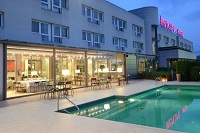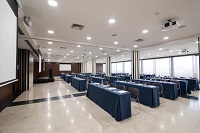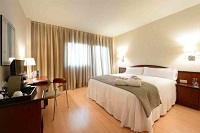Venue & Hospitality
Hotel Augusta Barcelona Valles AP-7, Km 12 5, 08410, Barcelona, Spain
Conference Dates: March 12-13 2018
Hotel Services & Amenities
- Audio/Visual Equipment Rental.
- Business Center.
- Business Phone Service.
- Complimentary Printing Service.
- Express Mail.
- Fax.
- Meeting Rooms.
- Office Rental.
- Photo Copying Service.
- Secretarial Service.
- Telex.
- Typewriter.
- Video Conference.
- Video Messaging.
- Video Phone.
- ATM.
- Baggage Storage.



Transportation
Driving Directions to
Barcelona is well connected with major cities through air and rail across Europe. Transportation From El Prat Airport: Takes 40 min (45.2 km) through the C-32 and C-33 From Barcelona-El Prat Airport T1, continue until the B-22 for about 1.0 km. Take the C-31, C-32, C-33, and AP-7 towards the BP-5002. Take Exit 13 from the AP-7. It is about 43.3 km. Hotel is on top of the hill and can be spotted as you exit the AP7 (exit 13).
Route Map
About City
It is the capital city of the autonomous community of Catalonia in the kingdom of Spain.It has countries second most populous municipality. It is the largest metropolis on the Mediterranean Sea, located on the coast between the mouths of the rivers Llobregat and Besòs, and bounded to the west by the Serra de Collserola mountain range, the tallest peak of which is 512 meters (1,680 feet) high. Barcelona has a rich cultural heritage and is today an important cultural center and a major tourist destination. Particularly renowned are the architectural works of Antoni Gaudí and Lluís Domènech I Montaner, which have been designated UNESCO World Heritage Sites. The headquarters of the Union for the Mediterranean is located in Barcelona. The city is known for hosting the 1992 Summer Olympics as well as world-class conferences and expositions and also many international sports tournaments.
Barcelona is one of the world's leading tourist, economic, trade fair and cultural centers, and its influence in commerce, education, entertainment, media, fashion, science, and the arts all contribute to its status as one of the world's major global cities. Barcelona has a humid subtropical climate bordering a maritime Mediterranean climate (Csa), with mildly cool winters and hot, muggy summers, while the rainiest seasons are autumn and spring.
Tourist Attraction:
Sagrada Familia
The Basilica of the Holy Family was the inspiration of a bookseller, Joseph Maria Bocabella, founder of Spiritual Association of Devotees of St. Joseph.
After a visit to the Vatican in 1872, Bocabella returned from Italy with the intention of building a church inspired by that at Loreto. The apse crypt of the church, funded by donations, was begun 19 March 1882, on the festival of St Joseph, to the design of the architect Francisco de Paula del Villar, whose plan was for a Gothic revival church of a standard form. The apse crypt was completed before Villar's resignation on 18 March 1883, when Gaudí assumed responsibility for its design, which he changed radically. Antoni Gaudi began work on the church in 1883 but was not appointed Architect Director until 1884.
Park Guell
The Park Guell is a public park system composed of gardens and architectural elements located on Carmel Hill, in Barcelona, Catalonia (Spain). Carmel Hill belongs to the mountain range of Collserola - the Carmel Park is located on the northern face. Park Guell is located in La Salut, a neighborhood in the Gracia district of Barcelona. With urbanization in mind, Eusebi Guell assigned the design of the park to Antoni Gaudí, a renowned architect and the face of Catalan modernism. The park was built between 1900 and 1914 and was officially opened as a public park in 1926. In 1984, UNESCO declared the park a World Heritage Site under "Works of Antoni Gaudí". Park Guell is the reflection of Gaudi’s artistic plenitude, which belongs to his naturalist phase (first decade of the 20th century). During this period, the architect perfected his personal style through inspiration from organic shapes. He put into practice a series of new structural solutions rooted in the analysis of geometry. To that, the Catalan artist adds creative liberty and an imaginative, ornamental creation. Starting from a sort of baroque, his works acquire a structural richness of forms and volumes, free of the rational rigidity or any sort of classic premises.
Casa Mila
Casa Mila popularly known as La Pedrera or "open quarry", a reference to its unconventional rough-hewn appearance, is a modernist building in Barcelona, Catalonia, Spain. It was the last private residence designed by architect Antoni Gaudí and was built between 1906 and 1910.
The building was commissioned in 1906 by businessman Pere Mila and his wife Roser Segimon. At the time, it was controversial because of its undulating stone facade, twisting wrought iron balconies and windows designed by Joseph Maria Jujol. Several structural innovations include a self-supporting stone front, columns, and floors free of load-bearing walls, an underground garage and sculptural elements on the roof.
In 1984, it was declared a World Heritage Site by UNESCO. It is currently the headquarters of the Fundacio Catalunya-La Pedrera which manages exhibitions and other activities at Casa Mila.
Casa Batllo
Casa Batllo is a renowned building located in the center of Barcelona and is one of Antoni Gaudi’s masterpieces. A remodel of a previously built house, it was redesigned in 1904 by Gaudi and has been refurbished several times after that. Gaudi's assistants Domenec Sugranes I Gras, Joseph Canaleta and Joan Rubio also contributed to the renovation project. The local name for the building is Casa dels ossos (House of Bones), as it has a visceral, skeletal organic quality.
Like everything Gaudi designed, it is only identifiable as Modernisme or Art Nouveau in the broadest sense. The ground floor, in particular, has unusual tracery, irregular oval windows and flowing sculpted stone work. There are few straight lines, and much of the façade is decorated with a colorful mosaic made of broken ceramic tiles (tren cadis). The roof is arched and was likened to the back of a dragon or dinosaur. A common theory about the building is that the rounded feature to the left of center, terminating at the top in a turret and cross, represents the lance of Saint George (patron saint of Catalonia, Gaudi's home), which has been plunged into the back of the dragon.
Placa d'Espanya
Placa d'Espanya also known as Plaza de Espana in Spanish, is one of Barcelona's most important squares, built on the occasion of the 1929 International Exhibition, held at the foot of Montjuic, in the Sants-Montjuic district. The square was built on a site that had been previously used for public hangings until the creation of the now demolished Ciutadella fortress in 1715, where the gallows were moved. It was designed in 1915 and built in 1929 so that it could be ready to host the 1929 Universal Exposition. The square has been in public use since then.
Magic Fountain of Montjuic
The Magic Fountain of Montjuic is a fountain located at the head of Avinguda Maria Cristina in the Montjuic neighborhood of Barcelona, Catalonia, Spain. The fountain is situated below the Palau Nacional on the Montjuic mountain and near the Placa d'Espanya and Poble Espanyol de Barcelona. The fountain, like most of the surrounding developments, was constructed for the 1929 Barcelona International Exposition.
The Magic Fountain was designed by Carles Buigas, who had designed illuminated fountains as early as 1922. The site where the fountain was constructed was the previous location of The Four Columns. The columns, the representative of the Catalanism movement, were demolished in 1928 under the orders of Prime Minister Miguel Primo de Rivera and were re-erected in 2010 a few meters away from the original location.
La Barceloneta
La Barceloneta is a neighborhood in the Ciutat Vella district of Barcelona, Catalonia, Spain. The neighborhood was constructed during the 18th century for the residents of the Ribera neighborhood who had been displaced by the construction of the Ciutadella of Barcelona. The neighborhood is roughly triangular, bordered by the Mediterranean Sea, the Moll d'Espanya of Port Vell, and the El Born neighborhood. This neighborhood even has its own flag. The neighborhood is serviced by its own stop on the Barcelona Metro (L4). This is a good starting point for whatever itinerary there may be to adventure through La Barceloneta. The yellow line, L4, which is the metro line that stops at La Barceloneta, is the most popular for pickpocketing. The neighborhood can also be discovered by taking Las Golondrinas which leave from the front port of the Columbus monument. This way the marine strip can be discovered, but the real charm of this neighborhood is getting lost in the side streets or alleyways. Torre Sant Sebastia is the terminus of the Port Vell Aerial Tramway; opened in 1931, it connects La Barceloneta with Montjuic across Port Vell.
La Barceloneta also homes a large Aquarium. This aquarium is said to be the biggest of Europe where one can discover an infinite quantity of marine life of the Mediterranean Sea. Space composes of 20 large tanks and a transparent tunnel by which one can pass through sharks.
